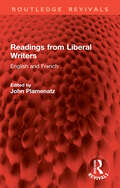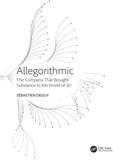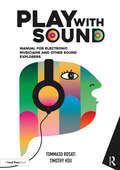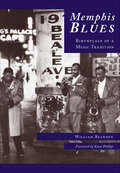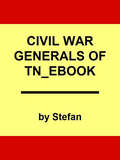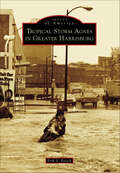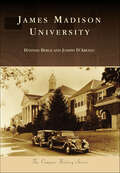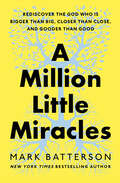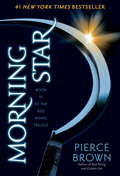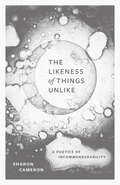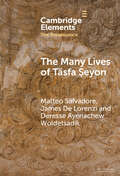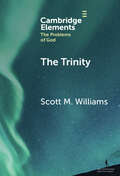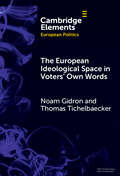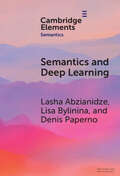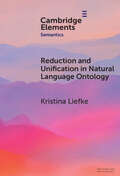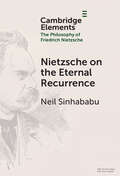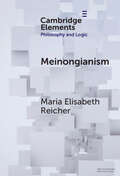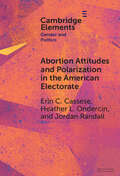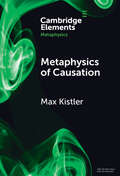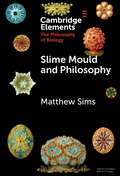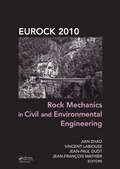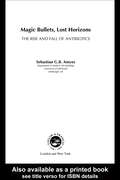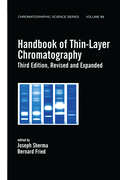- Table View
- List View
Readings from Liberal Writers: English and French (Routledge Revivals)
by John PlamenatzOriginally published in 1965, this volume provides selections of writings by English and French historians, philosophers and political scientists around the themes of freedom and opportunity; the functions of government; the spirit and machinery of free government; the freedom of thought and speech. The selections include Burke’s speeches, Locke’s Treatise of Civil Government, Mill on Liberty, Tocqueville on Democracy in America and Tawney on Equality. At a time in the 21st Century when freedom and democracy are under threat across the world, this book with its explanatory introduction by John Plamenatz has an enduring relevance.
Allegorithmic: The Company That Brought Substance to the World of 3D
by Sébastien DeguyAllegorithmic: The Company That Brought Substance to the World of 3D explores the journey of Allegorithmic, the software company behind Substance, a suite of tools that revolutionized texturing in computer graphics. This engaging narrative by Sébastien Deguy, the visionary founder and CEO of the company, chronicles the growth of Allegorithmic from its inception as a small startup to becoming a leader in digital content creation, pivotal in shaping the visual aesthetics of video games and films.The book highlights key technological innovations and strategic decisions that propelled the company forward, offering a detailed look at the challenges and triumphs of developing cutting-edge software solutions while building a team attached to its strong values and passion for digital artists.Key Features: Provides a detailed history of Allegorithmic, a company at the forefront of technological innovation in procedural textures and 3D content. Covers significant technical ground, discussing complex environments, procedural textures, and software development, while also delving into the creative aspects of these technologies. Spans the growth of a startup into a major player in the tech industry, providing insights into business strategies, team building, and international expansion. Reflects on the cultural shifts within the company and the broader industry, offering lessons on adapting to technological advancements and market demands. Ideal for tech enthusiasts, artists, and entrepreneurs, this deep book provides a comprehensive overview of the creativity and perseverance required to influence and lead in the tech industry.
Global Politics: A New Introduction
by Maja Zehfuss Jenny Edkins Thomas GregoryGlobal Politics: A New Introduction engages directly with questions that those coming to the study of world politics bring with them. From that innovative starting point, it explores key issues through a critical and inquiring perspective, presenting theoretical ideas and concepts in conjunction with a global range of historical and contemporary case studies.Revised and updated throughout, the fourth edition offers examples engaging with the latest developments in global politics: the climate crisis and anthropocentrism, Indigenous experiences and thinking, racism and the rise of xenophobia, artificial intelligence, citizen journalism, global health and pandemic response and drone warfare.Global Politics:• examines most significant issues in global politics – poverty, development, colonialism, human rights, gender, inequality, race, war, peacebuilding, security, violence, nationalism, authority and what we can do to change the world;• offers chapters written to a common structure ideal for teaching and learning and features a key question, an illustrative example, general responses and broader issues;• integrates theory and practice throughout the text, drawing on international relations, political theory, postcolonial studies, sociology, geography, peace studies and development.This exciting, up-to-date and ground-breaking textbook is essential reading for all those concerned about global politics.
Play with Sound: Manual for Electronic Musicians and Other Sound Explorers
by Tommaso Rosati Timothy HsuPlay with Sound: Manual for Electronic Musicians and Other Sound Explorers offers a thorough introduction to music technology by centering on curiosity and creativity in the exploration of the fundamentals of sound.With color illustrations throughout, this book covers topics regarding audio software, acoustical principles, electroacoustic systems, audio processing, sound synthesis, and communication protocols. Each chapter features creative exercises that utilize live electronics, production, and composition to unearth the theories presented and develop technical and musical creativity. Additionally, interactive graphics and lesson slides are available as digital resources to enhance learning inside and outside the classroom.Play with Sound is an ideal textbook for beginners of all backgrounds looking for an introduction to music technology, production, and live electronics. By engaging with this book, everyone, including traditional students as well as those learning outside the traditional classroom setting, will be able to expand their musical skills and professional opportunities into the world of music technology.
Memphis Blues: Birthplace of a Music Tradition
by William BeardenThe blues was born in the Mississippi Delta, and since that fateful night in 1903 when W. C. Handy heard the mournful sound of a pocketknife sliding over the strings of an acoustic guitar and the plaintive song of a long-forgotten musician in the hot night of Tutwiler, Mississippi, the blues has been on a journey around the world. From the cotton fields and jukejoints of the Delta, up Highway 61 to Memphis�s Beale Street, St. Louis, the Southside of Chicago, England, and points beyond, the blues is America�s unique form of music. Blues is incisive in its honesty, elemental in its rhythm,and powerful in its almost visceral sensation. Nearly every style of popular music has its roots in the blues. Muddy Waters said it best: �The blues had a baby, and they called it rock and roll.� Memphis has become the heart of the blues world, with a re-born Beale Street acting as its spiritual center. People come from the world over to experience its beat, savor its emotion, and feel its power. In the end . . . �it ain�t nothin� but the blues.�
Civil War Generals of Tennessee
by Randy BishopFrom James Patton Anderson to Felix Zollicoffer, author Randy Bishop, a native Tennessean, offers compelling portraits of the sons of a state regarded by many as the most torn asunder by the War Between the States. This collection brings together biographies of the fifty-one Confederate and Union generals born in Tennessee as well as those with significant ties to the state. Each entry focuses on the major military contributions of the individuals—no matter their affiliations—and also teases out the most intriguing aspects of their civilian life, particularly how they fared after the war. With fascinating details, including the men&’s relationships before the divisiveness of war drove intruded, Bishop provides an insight into lives that have rarely been seen as a whole. Arranged in alphabetical order for ease of reference, the work includes such luminaries as Nathan Bedford Forrest and Leonidas Polk, while also detailing the contributions of many lesser-known figures, including Samuel Powhatan Carter and Otho French Strahl. Each entry spans approximately five pages and provides, as the author states, &“insight into the contributions of selfless men who offered their best, in years of their lives as well as time, that could have been spent with their families.&”
Tropical Storm Agnes in Greater Harrisburg
by Erik V. FasickTropical Storm Agnes, along with the unprecedented flooding which resulted from it, is arguably the most significant event to have transpired in the Harrisburg area in the last 150 years. Over the course of June 21 and June 22, 1972, Agnes drenched the region with more than a foot of rain. As a result, the Susquehanna River rose to record-breaking levels and backed into the already overwhelmed feeding creeks and streams. In Harrisburg, armed National Guardsmen patrolled the vacant streets and set up checkpoints to enforce a curfew and deter looting. Surrounded by floodwaters, row homes near the governor�s mansion burned, and firefighters waded through chest-high water as they attempted to reach the blaze. Entire neighborhoods in both Shipoke and Steelton were ultimately lost due to the high waters entering homes. To this day, Agnes continues to serve as the measuring stick by which all storms since have been judged.
James Madison University (Campus History)
by Hannah BergeAnyone strolling through James Madison University's bucolic Bluestone area, which is grounded by the iconic Wilson Hall, will feel the educational journeys of past students resonating through the air. Founded in 1908 as a women's college, James Madison University was originally called the State Normal and Industrial School for Women at Harrisonburg and had an opening enrollment of 150 students. Since then, James Madison University has undergone several name changes and has a current enrollment of over 20,000 students. "The Madison Experience" is one that involves a commitment to learning and a fun and open spirit. This retelling of campus history seeks to capture some of the defining moments and cherished memories that have shaped so many Dukes.
A Million Little Miracles: Rediscover the God Who Is Bigger Than Big, Closer Than Close, and Gooder Than Good
by Mark BattersonThe New York Times bestselling author of Win the Day reminds us of the millions of miracles God performs every day and inspires us to live with a clearer sense of identity and purpose.Think you&’ve never experienced a miracle? With all due respect, you have never not. In fact, you are one!There never has been—and there never will be—anyone else like you. That isn&’t a testament to you. It&’s a testament to the God who created you. Your fingerprint, eyeprint, and voiceprint are unlike anyone else&’s. Simply put, you matter to God.Most of us take everyday miracles for granted, including the one that stares back at us in the mirror. It&’s time to take them for gratitude. Why is that so important? Because whatever you don&’t turn into praise turns into pride. The miracle of life becomes mundane. We get so wrapped up in our own little world, we end up worshipping a god who looks like us, acts like us, and thinks like us. It&’s no wonder we&’ve lost our wonder. But there is a way to recapture holy curiosity!In A Million Little Miracles, New York Times bestselling author Mark Batterson reveals three miraculous truths that awaken us to carpe wonder for the Creator and His creation:1. God Is Bigger Than We Think—we can rest in His wisdom and strength2. God Is Closer Than We Realize—we never have to do life alone3. God Is Better Than We Imagine—we can reclaim our childlike wonderA million little miracles are waiting to be discovered, including the miracle called you.
Morning Star: Book 3 of the Red Rising Saga (Red Rising Series #3)
by Pierce Brown#1 NEW YORK TIMES BESTSELLER • Red Rising thrilled readers and announced the presence of a talented new author. Golden Son changed the game and took the story of Darrow to the next level. Now comes the exhilarating next chapter in the Red Rising Saga: Morning Star.ITW THRILLER AWARD FINALIST • &“[Brown&’s] achievement is in creating an uncomfortably familiar world of flaw, fear, and promise.&”—Entertainment WeeklyDarrow would have lived in peace, but his enemies brought him war. The Gold overlords demanded his obedience, hanged his wife, and enslaved his people. But Darrow is determined to fight back. Risking everything to transform himself and breach Gold society, Darrow has battled to survive the cutthroat rivalries that breed Society&’s mightiest warriors, climbed the ranks, and waited patiently to unleash the revolution that will tear the hierarchy apart from within. Finally, the time has come. But devotion to honor and hunger for vengeance run deep on both sides. Darrow and his comrades-in-arms face powerful enemies without scruple or mercy. Among them are some Darrow once considered friends. To win, Darrow will need to inspire those shackled in darkness to break their chains, unmake the world their cruel masters have built, and claim a destiny too long denied—and too glorious to surrender.Praise for Morning Star&“There is no one writing today who does shameless, Michael Bay–style action set pieces the way Brown does. The battle scenes are kinetic, bloody, breathless, crazy. Everything is on fire all the time.&”—NPR &“Morning Star is this trilogy&’s Return of the Jedi. . . . The impactful battles that make up most of Morning Star are damn near operatic. . . . It absolutely satisfies.&”—Tordotcom &“Excellent . . . Brown&’s vivid, first-person prose puts the reader right at the forefront of impassioned speeches, broken families, and engaging battle scenes . . . as this interstellar civil war comes to a most satisfying conclusion.&”—Publishers Weekly (starred review) &“A page-turning epic filled with twists and turns . . . The conclusion to Brown&’s saga is simply stellar.&”—Booklist (starred review)Don&’t miss any of Pierce Brown&’s Red Rising Saga:RED RISING • GOLDEN SON • MORNING STAR • IRON GOLD • DARK AGE • LIGHT BRINGER
The Hot Zone: The Terrifying True Story of the Origins of the Ebola Virus (Large Print Bks.)
by Richard PrestonThe bestselling landmark account of the first emergence of the Ebola virus. Now a mini-series drama starring Julianna Margulies, Topher Grace, Liam Cunningham, James D'Arcy, and Noah Emmerich on National Geographic.A highly infectious, deadly virus from the central African rain forest suddenly appears in the suburbs of Washington, D.C. There is no cure. In a few days 90 percent of its victims are dead. A secret military SWAT team of soldiers and scientists is mobilized to stop the outbreak of this exotic "hot" virus. The Hot Zone tells this dramatic story, giving a hair-raising account of the appearance of rare and lethal viruses and their "crashes" into the human race. Shocking, frightening, and impossible to ignore, The Hot Zone proves that truth really is scarier than fiction.
The Likeness of Things Unlike: A Poetics of Incommensurability
by Sharon CameronA study of the incommensurable, often discordant elements that define major works of American literature. In Sharon Cameron’s essays, a magnetic constellation gathers works of Emerson, Whitman, Dickinson, Cather, and Stevens—each manifesting in its own terms “the likeness of things unlike”—to form a loose commonality in a strain of American writing in which incommensurable elements can’t be integrated and can’t be separated. The Likeness of Things Unlike is concerned with discordant elements of an aesthetic work and argues that these elements refigure the aesthetic wholes whose integrity they apparently violate. These intertwined, subversive elements are challenges to literary systems and are essentially philosophical in their rethinking of categories, and thus go beyond the aesthetic particulars that exemplify them. Cameron is known for rigorously and brilliantly connecting artistic achievement to radical ways of thinking. Georg Lukcás describes the essayist as one who “adapts himself to the essay’s ‘smallness’ of form—the eternal smallness of the most profound work of the intellect in [the] face of life.” With The Likeness of Things Unlike Cameron powerfully demonstrates Lukács’s remarkable insight.
The Many Lives of Täsfa Ṣeyon: An Ethiopian Intellectual in Early Modern Rome (Elements in the Renaissance)
by Matteo Salvadore James De Lorenzi Deresse Ayenachew WoldetsadikThis Element examines the life and legacy of the sixteenth-century Ethiopian intellectual Täsfa Ṣeyon. It reconstructs his formative years in the Horn of Africa and his diasporic life in the Holy Land and Italian peninsula, where he emerged as a prominent intermediary figure at Santo Stefano degli Abissini, an Ethiopianmonastery within the Vatican. He became a librarian, copyist, teacher, translator, author, and community leader, as well as a prominent advisor to European humanist scholars and Tridentine Church authorities concerned with the emerging field of philologia sacra as it pertained to Ethiopian Orthodox (täwaḥedo) Christianity. The Element reconstructs his wide-ranging contacts with the Roman Curia and emerging orientalist academy, and then scrutinizes his editio princeps of the Ge'ez Gospels. A final section traces his modern influence, erasure, and rediscovery by later generations of European, Ethiopian, and Eritrean intellectuals.
The Trinity (Elements in the Problems of God)
by Scott M. WilliamsThe doctrine of the Trinity, proclaimed by Christians through the Nicene-Constantinople creed, is foundational to traditional Christian belief and worship of God. But is this doctrine logically coherent? How can there be three divine persons (Father, Son, and Holy Spirit), each is God, and yet there is only one God? This is a fundamental question for philosophers, but theologians have additional questions. This Element addresses philosophical and theological issues concerning the Trinity: Hermeneutical and Logical problems, Personal Pronouns, Monarchy, Equality, the Greek vs. Latin filioque debate, Real Relations, Unity of Action, Self-Knowledge in the Trinity, and Simplicity. Based on my recent rediscovery of the sixth ecumenical council's (Constantinople III) clarifications of Trinitarian doctrine, this Element introduces Conciliar Trinitarianism and shows how it responds to the issues, including a resolution to the fundamental logical question. It also compares Conciliar Trinitarianism with Miaphysite, neo-Sabellian, Social, and other models of the Trinity.
The European Ideological Space in Voters' Own Words (Elements in European Politics)
by Noam Gidron Thomas TichelbaeckerThere is a broad consensus that the ideological space of Western democracies consists of two distinct dimensions: one economic and the other cultural. In this Element, the authors explore how ordinary citizens make sense of these two dimensions. Analyzing novel survey data collected across ten Western democracies, they employ text analysis techniques to investigate responses to open-ended questions. They examine variations in how people interpret these two ideological dimensions along three levels of analysis: across countries, based on demographic features, and along the left-right divide. Their results suggest that there are multiple two-dimensional spaces: that is, different groups ascribe different meanings to what the economic and cultural political divides stand for. They also find that the two dimensions are closely intertwined in people's minds. Their findings make theoretical contributions to the study of electoral politics and political ideology.
Semantics and Deep Learning (Elements in Semantics)
by Lasha Abzianidze Lisa Bylinina Denis PapernoThis Element covers the interaction of two research areas: linguistic semantics and deep learning. It focuses on three phenomena central to natural language interpretation: reasoning and inference; compositionality; extralinguistic grounding. Representation of these phenomena in recent neural models is discussed, along with the quality of these representations and ways to evaluate them (datasets, tests, measures). The Element closes with suggestions on possible deeper interactions between theoretical semantics and language technology based on deep learning models.
Reduction and Unification in Natural Language Ontology (Elements in Semantics)
by Kristina LiefkeSemantic theories for natural language assume many different kinds of objects, including (among many others) individuals, properties, events, degrees, and kinds. Formal type-theoretic semantics tames this 'zoo' of objects by assuming only a small number of ontologically primitive categories and by obtaining the objects of all other categories through constructions out of these primitives. This Element surveys arguments for this reduction of semantic categories. It compares the ontological commitments of different such reductions and establishes relations between competing foundational semantic ontologies. In doing so, it yields insights into the requirements on minimal semantic ontologies for natural language and the challenges for semantic ontology engineering.
Nietzsche on the Eternal Recurrence (Elements in the Philosophy of Friedrich Nietzsche)
by Neil SinhababuThe idea of the eternal recurrence is that we will live the exact same lives again an infinite number of times. Nietzsche appreciates that this would multiply the value of a single life by infinity, justifying intense emotional responses. His unpublished notes provide a cosmological argument for the eternal recurrence that anticipates Poincaré's recurrence theorem. Nietzsche's Thus Spoke Zarathustra describes its hero discovering this idea and struggling to accept the recurrence of all bad things. He eventually comes to love the eternal recurrence because it will bring back all the joys of his life, and teaches this idea to others.
Meinongianism (Elements in Philosophy and Logic)
by Maria Elisabeth ReicherMeinongianism (named after Alexius Meinong) is, roughly, the view that there are not only existent but also nonexistent objects. In this book, Meinong's so-called object theory as well as “neo-Meinongian” reconstructions are presented and discussed, especially with respect to logical issues, both from a historical and a systematic perspective. Among others, the following topics are addressed: basic principles and motivations for Meinongianism; the distinction between “there is” (“ x”) and “exists” (“E!”); interpretations and kinds of quantification; Meinongianism, the principle of excluded middle and the principle of non-contradiction; the nuclear-extranuclear distinction and modes of predication; varieties of neo-Meinongianism and Meinongian logics.
Abortion Attitudes and Polarization in the American Electorate (Elements in Gender and Politics)
by Erin C. Cassese Heather L. Ondercin Jordan RandallAbout two-thirds of Americans support legal abortion in many or all circumstances, and this group finds itself a frustrated majority following the Supreme Court's 2022 decision in Dobbs v. Jackson Women's Health Organization which overturned the legal precedent set in Roe v. Wade. Previous scholarship argues intense minorities can secure favorable policy outcomes when facing off against a more diffuse and less motivated majority, creating incongruence between public opinion and policy. This Element focuses on the ways that preference intensity and partisan polarization have contributed to the current policy landscape surrounding abortion rights. Using survey data from the American National Election Studies, the authors identify Americans with intense preferences about abortion and investigate the role they play in electoral politics. They observe a shift in the relationship between partisanship and preference intensity coinciding with Dobbs and speculate about what this means for elections and policy congruence in the future.
Metaphysics of Causation (Elements in Metaphysics)
by Max KistlerThis Element presents the main attempts to account for causation as a metaphysical concept, in terms of 1) regularities and laws of nature, 2) conditional probabilities and Bayes nets, 3) necessitation between universals and causal powers, 4) counterfactual dependence, 5) interventions and causal models, and 6) processes and mechanisms. None of these accounts can provide a complete reductive analysis. However, some provide the means to distinguish several useful concepts of causation, such as total cause, contributing cause, direct and indirect cause, and actual cause. Moreover, some of these accounts can be construed so as to complement each other. The last part presents some contemporary debates: on the relation between grounding and causation, eliminativism with respect to causation in physics, the challenge against 'downward' causation from the Closure and Exclusion principles, robust and proportional causation, and degrees of causation. This title is also available as Open Access on Cambridge Core.
Slime Mould and Philosophy (Elements in the Philosophy of Biology)
by Matthew SimsPhysarum polycephalum, also known more colloquially as 'the blob', 'acellular slime mould', or just 'slime mould', is a unicellular multinucleate protist that has continued to attract the interest of biologists over the past century because of its complex life cycle, unique physiology, morphology, and behaviour. More recently, attention has shifted to Physarum as a model organism for investigating putative cognitive capacities such as decision making, learning, and memory in organisms without nervous systems. The aim of this Element is to illustrate how Physarum can be used as a valuable tool for approaching various topics in the philosophy of biology. Physarum and its behaviour not only pose a challenge to some of the received views of biological processes but also, I shall argue, provide an opportunity to clarify and appropriately sharpen the concepts underlying such received views.
Rock Mechanics in Civil and Environmental Engineering
by Jian Zhao Vincent Labiouse Jean-Paul Dudt Jean-François MathierDuring the last two decades rock mechanics in Europe has been undergoing some major transformation. The reduction of mining activities in Europe affects heavily on rock mechanics teaching and research at universities and institutes. At the same time, new emerging activities, notably, underground infrastructure construction, geothermal energy develo
Magic Bullets, Lost Horizons: The Rise and Fall of Antibiotics
by Sebastian G. AmyesFrom the day that Paul Ehrlich hailed his newly discovered treatment for syphilis as the magic bullet, antibiotics have transformed medical practice. They are considered one of the miracle drugs of the 20th century. However, the massive and increasing misuse of these agents is More...causing a problem of resistance that may prove to be one of the greatest threats to health in the 21st century. Magic Bullets, Lost Horizons aims to put some of the media sensationalism into perspective. It examines not only the development of modern antibiotics but also the obstacles faced during application of the drugs and their expected efficacy in the future.
Handbook of Thin-Layer Chromatography
by Bernard Fried Joseph ShermaIn this third edition, more than 40 renowned authorities introduce and update chapters on the theory, fundamentals, techniques, and instrumentation of thin-layer chromatography (TLC) and high-performance thin-layer chromatography (HPTLC), highlighting the latest procedures and applications of TLC to 19 important compound classes and coverage of TLC applications by compound type. Easily adaptable to industrial scenarios , the Handbook of Thin-Layer Chromatography, Third Edition supports practical research strategies with extensive tables of data, offers numerous figures that illustrate techniques and chromatograms, and includes a glossary as well as a directory of equipment suppliers.
